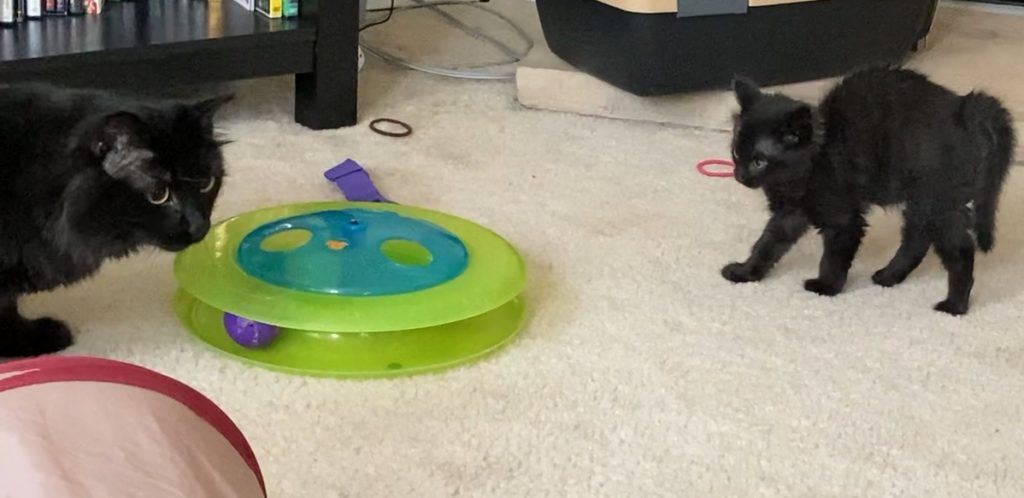
You have decided that you want to get another cat. Why not a kitten? A kitten is young; he or she should be adaptable and open to new experiences. Right?
Before you go to the shelter or call a breeder, think first of your resident cats: their ages, health and life experience.
Introducing Kittens to Older Cats
Scenario #1: senior cats
Let’s say your oldest cat is ten years old, comparable to a 56 year old human. She still is up for a rousing game of “chase the feather bird” but she is not forever pouncing on toys. She is still jumping pretty well but does spend a lot of her time in sunny spots, snoozing and soaking up the warmth.
Her health is pretty good for her age but she most likely has started to develop arthritis. You don’t know much about her early life (she was a rescue) but she gets along fairly well with the now 7 year old male cat you adopted when she was 3 years old. You recall that it took some time for them to accept each other but they will snuggle together in winter and groom each other’s heads from time to time.
If you could ask your two senior cats if they want a kitten roommate, they would probably say “No, please maintain the status quo”. An energetic kitten may be more than they want to deal with. However, the two cats form an established social group, know the rules of feline etiquette, so there is a good chance that introducing a new cat will be successful.
The newcomer may or may not be accepted whole-heartedly into this social group. You may end up dealing with two social groups – your older cats and the kitten. Think about getting two kittens, ideally from the same litter. They will form their own rough and tumble social club and the older cats will not need to join the fracas unless they want to.
scenario #2: the single young adult cat
In this case, you have a young male cat about 1 year old. You adopted him when he was a 10 week old kitten and he has been the only cat in the house since. He is still rambunctious and playful. You feel he would benefit from a younger companion.
Although this cat is still young, his socialization with other cats stopped at 10 weeks. He may tend to view a kitten more as an object, a toy to be played with, than a member of a social group. The introduction process could be more complicated than introducing kittens to older cats that have been socialized. This young, single cat will benefit from training and possibly medication to put him in a relaxed emotional state while meeting his new roommate.
The Nuts and bolts of introducing kittens to older cats
It is wise to follow the basic rules of introducing cats in both scenarios. Give your resident(s) time to get used to the idea of sharing the house with a furry newcomer. Start with:
- Scent exchange
- Time-sharing of common areas
- Visual introduction with a barrier in between.
Time with the barrier in between can give you an idea of how the older cat(s) and kitten(s) will react. Make sure everyone is offered high value treats and toys and consider having a helper so there is a person on either side of the barrier. Have a sheet or blanket to cover the barrier if needed.

Consider harness/leash training both kitten(s) and adult cat(s). The harness/leash can give you more control over the visitations by regulating how cats approach each other. A leash can keep a rambunctious kitten from pouncing on a senior cat; a leash can help keep an overstimulated young adult cat from relentlessly pursuing a kitten.
A word to the wise…
- Assess the medical and social history of your resident cat(s) when planning to adopt a new kitten or cat.
- Go slowly when introducing kittens to older cats – an older cat can hurt a young kitten. Supervision is a must!
- Watch everyone’s body language: take a step back if there’s a lot of hissing and growling.
- Always be ready to separate fighting felines!

